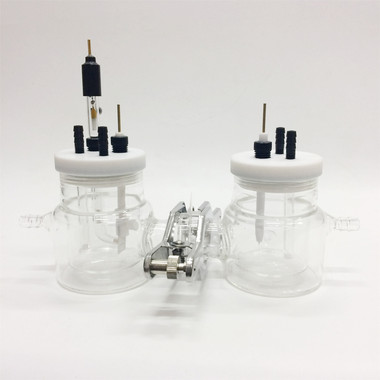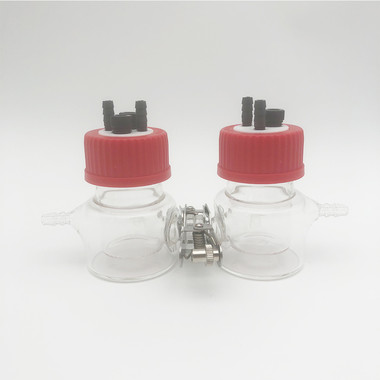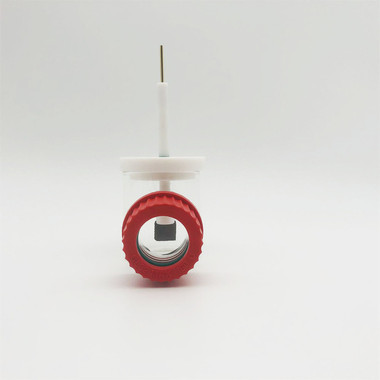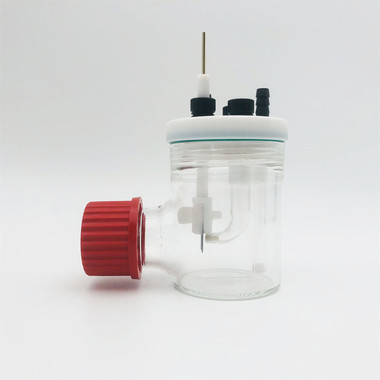Ordinary Electrochemical Cell 150ml$100.95$125.95
Ordinary Electrochemical Cell 200ml$110.95$140.95
Ordinary Electrochemical Cell 300ml$120.95$150.95
Ordinary Electrochemical Cell 500ml$150.95$190.95
 H Type Electrochemical Cell Sealed 50ml 60ml$360.95$450.95
H Type Electrochemical Cell Sealed 50ml 60ml$360.95$450.95 H Type Sealed Electrochemical Cell 30ml 45ml$400.95$500.95
H Type Sealed Electrochemical Cell 30ml 45ml$400.95$500.95H Type Sealed Electrochemical Cell 15ml 40ml$440.95$550.95
In Situ Raman Electrochemical Cell Spectroscopy Cell 30ml$1,960.95$2,180.95
In Situ Raman Spectroscopy Electrochemical Cell 10ml$2,250.95$2,500.95
In Situ Raman Spectroscopy Cell With Double Light Window 30ml$2,250.95$2,800.95
In Situ Raman Spectroscopy Cell With Double Light Window 10ml$2,250.95$2,500.95
H Type In Situ Raman Spectroscopy Cell With Single Light Window 30ml$2,450.95$3,050.95
H Type In Situ Raman Spectroscopy Cell With Single Light Window 10ml$2,950.95$3,430.95
Sealed Electrochemical Cell 5ml 15ml$240.95$300.95
 Sealed Electrochemical Cell 50ml$135.95$169.95
Sealed Electrochemical Cell 50ml$135.95$169.95 Sealed Electrochemical Cell 100ml$150.95$188.95
Sealed Electrochemical Cell 100ml$150.95$188.95 H Type Sealed Electrochemical Cell 60ml 100ml$420.95$525.95
H Type Sealed Electrochemical Cell 60ml 100ml$420.95$525.95 H Type Sealed Electrochemical Cell 20ml 45ml$400.95$500.95
H Type Sealed Electrochemical Cell 20ml 45ml$400.95$500.95H Type Sealed Electrochemical Cell 10ml 40ml$440.95$550.95
H Type Sealed Electrochemical Cell 5ml 15ml$480.95$600.95
H Type Glass Sand Core Sealed Electrolytic Cell 5ml 15ml$480.95$600.95
 Sealed Electrochemical Cell With Luggin 50ml$180.95$225.95
Sealed Electrochemical Cell With Luggin 50ml$180.95$225.95 Double Layer Temperature Controlled Corrosion Electrochemical Cell 500ml$1,800.95$2,000.95
Double Layer Temperature Controlled Corrosion Electrochemical Cell 500ml$1,800.95$2,000.95 Sealed Electrochemical Cell With Luggin 100ml$200.95$250.95
Sealed Electrochemical Cell With Luggin 100ml$200.95$250.95Sealed Electrochemical Cell With Luggin 150ml$240.95$300.95
Sealed Electrochemical Cell With Luggin 200ml$280.95$350.95
Sealed Electrochemical Cell With Luggin 250ml$360.95$450.95
Sealed Electrochemical Cell With Luggin 300ml$400.95$500.95
Sealed Electrochemical Cell With Luggin 500ml$480.95$600.95
 H Type Ptfe Photoelectrocatalysis Sealed Electrochemical Cell 50ml$1,100.95$1,375.95
H Type Ptfe Photoelectrocatalysis Sealed Electrochemical Cell 50ml$1,100.95$1,375.95 H Type Ptfe Photoelectrocatalysis Sealed Electrochemical Cell 100ml$1,200.95$1,500.95
H Type Ptfe Photoelectrocatalysis Sealed Electrochemical Cell 100ml$1,200.95$1,500.95H Type Peek Photoelectrocatalysis Sealed Electrochemical Cell 30ml$1,960.95$2,450.95
What is an Electrochemical Cell?
An electrochemical cell is a device that converts electrical energy into chemical energy. Electrolysis is a process in which an electric current passes through an electrolyte solution (or a molten electrolyte) to cause a redox reaction at the anode and cathode. The general electrochemical system is divided into two-electrode system and three-electrode system, and the three-electrode system is mostly used.
The Three Electrode System
The three-electrode system consists of a working electrode, a counter electrode and a reference electrode. The three-electrode system contains two circuits, one circuit is composed of a working electrode and a reference electrode, which is used to test the electrochemical reaction process of the working electrode. The other circuit is composed of a working electrode and a counter electrode, which functions to transmit electrons to form a circuit. In other words, the potential of the working electrode is relative to the reference electrode, and the counter electrode and the working electrode form a closed loop of a circuit.
The three-electrode system consists of two parts: the polarization circuit (constituted by the working electrode and the counter electrode) and the measurement circuit (constituted by the working electrode and the reference electrode). Polarization loop: realize the change and measurement of polarized current; Measurement loop: to achieve control or measurement of changes in polarization potential.
Advantages of the three-electrode system:
1. It can measure polarization current and polarization potential at the same time.
2. Three electrodes and two circuits have sufficient measurement accuracy. A salt bridge is required when the composition or concentration of the measurement is different from the system under test.
The function of salt bridge:
1. Eliminate or reduce the liquid junction potential.
2. Eliminate the pollution of the measurement system and the system under test.
Applications of Electrochemical Cell
The electrochemical measurement method is to attribute the change of the chemical substance to the electrochemical reaction, that is, the potential, current or electric quantity in the system is used as a measure of the chemical reaction in the system. Cyclic voltammetry has long been known for its multi-functional applications in many fields such as chemistry, physical chemistry, biochemistry, and biology that involve the process of electron transfer.
The electrochemical cell of three-electrode system can potentially be used, not limited to, for the following characterization and measurements of electrically driven chemical reactions of metal materials, inorganic non-metal materials, organic polymer materials.
- Chemical analysis and synthesis
- Redox potentials
- Electron transfer mechanism and reversibility of a reaction
- Thermodynamic and kinetic studies
- Corrosion evaluation test
- Battery and energy studies

 United Kingdom (GBP)
United Kingdom (GBP) Canada (CAD)
Canada (CAD) Australia (AUD)
Australia (AUD) Singapore (SGD)
Singapore (SGD) New Zealand (NZD)
New Zealand (NZD) Ireland (EUR)
Ireland (EUR) India (INR)
India (INR)







































